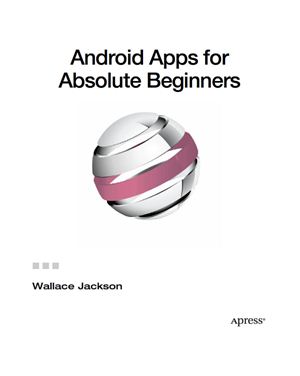Apress, 2011. - 328 p. - ISBN: 978-1-4302-3446-3
Android Apps For Absolute Beginners - это книга для начинающих,
поэтому автор начинает с самого начала, показывая, где скачать и
как установить различные Android, Java и Eclipse, среды, а также
учит настройке их, как настроить их для применения разработки и
тестирования. Это само по себе задача не из легких, и должно быть
сделано правильно, так как эти инструменты обеспечивают основу для
всех Android разработок, отладки и тестирования изложенных в
основной части книги.
Because this is a book for absolute beginners, we start at the very
beginning, showing where to download and how to install the various
Android, Java, and Eclipse environments, as well as how to
configure these environments and how to set them up for application
development and testing. This in itself is no easy task, and must
be done correctly, as these tools provide the foundation for all of
our Android development, debugging, and testing for the remainder
of the book. Next I will provide you with an overview of where
Android came from, why, how, and when Google acquired it, and how
it is uniquely structured among software development platforms. I
will introduce XML, Java, OOP, and Android concepts soon after
that, as well as cover how Android manages its screen layout. We
will then move these concepts into use in later chapters in the
second half of the book; these chapters explain the most important
concepts in Android in their most logical order as they pertain to
applications development.
Next I will provide you with an overview of where Android came from, why, how, and when Google acquired it, and how it is uniquely structured among software development platforms. I will introduce XML, Java, OOP, and Android concepts soon after that, as well as cover how Android manages its screen layout. We will then move these concepts into use in later chapters in the second half of the book; these chapters explain the most important concepts in Android in their most logical order as they pertain to applications development. In that second half of the book, we’ll start getting into developing a user interface (UI), as that is the front-end or interface for your user to your Android application. Soon after we'll cover how your UI talks to your application via events processing. To spice up your application’s visual appearance, we’ll get into graphics, animation, and video, and then get into even more advanced topics after that, such as databases and communications. Finally we will look at some of the advanced features of Android that you will want to visit after finishing the book; these are topics that are too advanced for a first book on Android but which provide some of the coolest features in smartphone development today. We’ll walk you through all of these topics and concepts with screenshots of the IDE and visual examples and then take you though step-by-step examples reinforcing these concepts. Sometimes we will repeat previous topics to reinforce what you have leaed and apply these skills in new ways. This enables new programmers to re-apply development skills and feel a sense of accomplishment as they progress.
Next I will provide you with an overview of where Android came from, why, how, and when Google acquired it, and how it is uniquely structured among software development platforms. I will introduce XML, Java, OOP, and Android concepts soon after that, as well as cover how Android manages its screen layout. We will then move these concepts into use in later chapters in the second half of the book; these chapters explain the most important concepts in Android in their most logical order as they pertain to applications development. In that second half of the book, we’ll start getting into developing a user interface (UI), as that is the front-end or interface for your user to your Android application. Soon after we'll cover how your UI talks to your application via events processing. To spice up your application’s visual appearance, we’ll get into graphics, animation, and video, and then get into even more advanced topics after that, such as databases and communications. Finally we will look at some of the advanced features of Android that you will want to visit after finishing the book; these are topics that are too advanced for a first book on Android but which provide some of the coolest features in smartphone development today. We’ll walk you through all of these topics and concepts with screenshots of the IDE and visual examples and then take you though step-by-step examples reinforcing these concepts. Sometimes we will repeat previous topics to reinforce what you have leaed and apply these skills in new ways. This enables new programmers to re-apply development skills and feel a sense of accomplishment as they progress.

